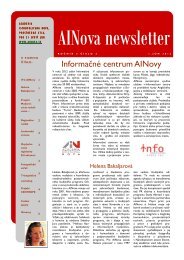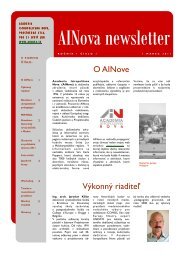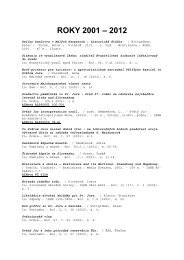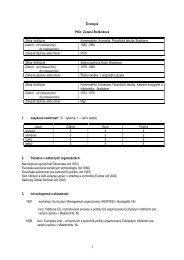The Argument about the Cultural Heritage Value and its Assessment ...
The Argument about the Cultural Heritage Value and its Assessment ...
The Argument about the Cultural Heritage Value and its Assessment ...
You also want an ePaper? Increase the reach of your titles
YUMPU automatically turns print PDFs into web optimized ePapers that Google loves.
similar cases by clarifying <strong>the</strong> scope of <strong>the</strong> legal framework <strong>and</strong> examining <strong>the</strong> possibilities to<br />
save <strong>the</strong> heritage in <strong>the</strong> future.<br />
II.Gumon - Hi(S)tory<br />
<strong>The</strong> site of former Gumon factory is situated in <strong>the</strong> south-eastern direction off <strong>the</strong><br />
historical centre of Bratislava on <strong>the</strong> broad plain near Danube. This area regularly flooded by<br />
Danube has been only scarcely inhabited with farmsteads until <strong>the</strong> regulation of Danube river<br />
in <strong>the</strong> last third of 18 th century. Due to <strong>its</strong> location <strong>and</strong> <strong>the</strong> passage of several roads <strong>and</strong> horse<br />
railway (1840 - 1872) <strong>the</strong> site has been predetermined for development of industry. <strong>The</strong><br />
political compromise between Austria <strong>and</strong> Hungary in 1867 removed <strong>the</strong> last obstacles to <strong>the</strong><br />
industrial development <strong>and</strong> Bratislava soon became one of <strong>the</strong> most important industrial<br />
centres of Austrian – Hungarian empire 3 . Gumon factory had been established in Bratislava<br />
by Viennese entrepreneur Otto Bondy as a branch of his already existing Cable factory. <strong>The</strong><br />
management of <strong>the</strong> factory was h<strong>and</strong>ed over to his son Egon Bondy in 1910, who was due to<br />
his success able to acquire similar factories elsewhere in Central Europe. Egon Bondy bought<br />
<strong>the</strong> plots at south-eastern direction from <strong>the</strong> city centre at nowadays location <strong>and</strong> on 13 th July<br />
1911 created new „Gumon factory Mlynské Nivy“, which specialised in <strong>the</strong> production of<br />
early plastics, namely bakelite 4 . Gumon factory has been in operation throughout <strong>the</strong> first<br />
Czechoslovak Republik (1918-1939), <strong>and</strong> period between 1948 - 1989 in <strong>the</strong> legal form of<br />
state - owned enterprise (Gumon n.p.) <strong>and</strong> after 1990 in <strong>the</strong> form of corporation (Gumon<br />
Bratislava a.s.). Year 2005 has been milestone for <strong>its</strong> future: <strong>the</strong> plots with <strong>the</strong> adjoining<br />
factory buildings have been acquired into <strong>the</strong> ownership of a company which terminated <strong>the</strong><br />
production in Gumon. Almost all of <strong>the</strong> buildings belonging to <strong>the</strong> former Gumon factory<br />
have been demolished in <strong>the</strong> symbolic dates between Friday 29 th August <strong>and</strong> Monday 1 st<br />
September 2008, where 29 th August is reminder of Slovak National Uprising in 1944 against<br />
3 Between 19th <strong>and</strong> 20th century major factories were built <strong>and</strong> operating, in particular : Tobacco plant,<br />
Kuhmayer's plant (technical glass), Patrónka, Gruneberg’s plant (brushes), Marschall’s plant (carrriages)<br />
Dynamitka, Durvay’s brick plant, Menzl’s plant for cardboard <strong>and</strong> asphalt, Klingerka, Kablovka, Apollo<br />
refinery, Stollwerck plant, Sfinx (smalto kitchenware), Siemens-Schuckert’s plant (BEZ), Cvernovka, Matador,<br />
Bro<strong>the</strong>rs Harschs’ saw mill, Danubius (textiles) <strong>and</strong> Gumon.<br />
4 Bakelite was an early plastic developed in 1907–1909 by Belgian chemist Dr. Leo Baekel<strong>and</strong>.It was a material<br />
with thous<strong>and</strong> uses: dial telephones, radios, cameras, jewellery, wire installer material etc. It has become a<br />
st<strong>and</strong>ard item in <strong>the</strong> family home of <strong>the</strong> 1930s <strong>and</strong> 1940s. http://en.wikipedia.org/wiki/Bakelite<br />
3
















